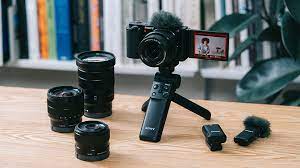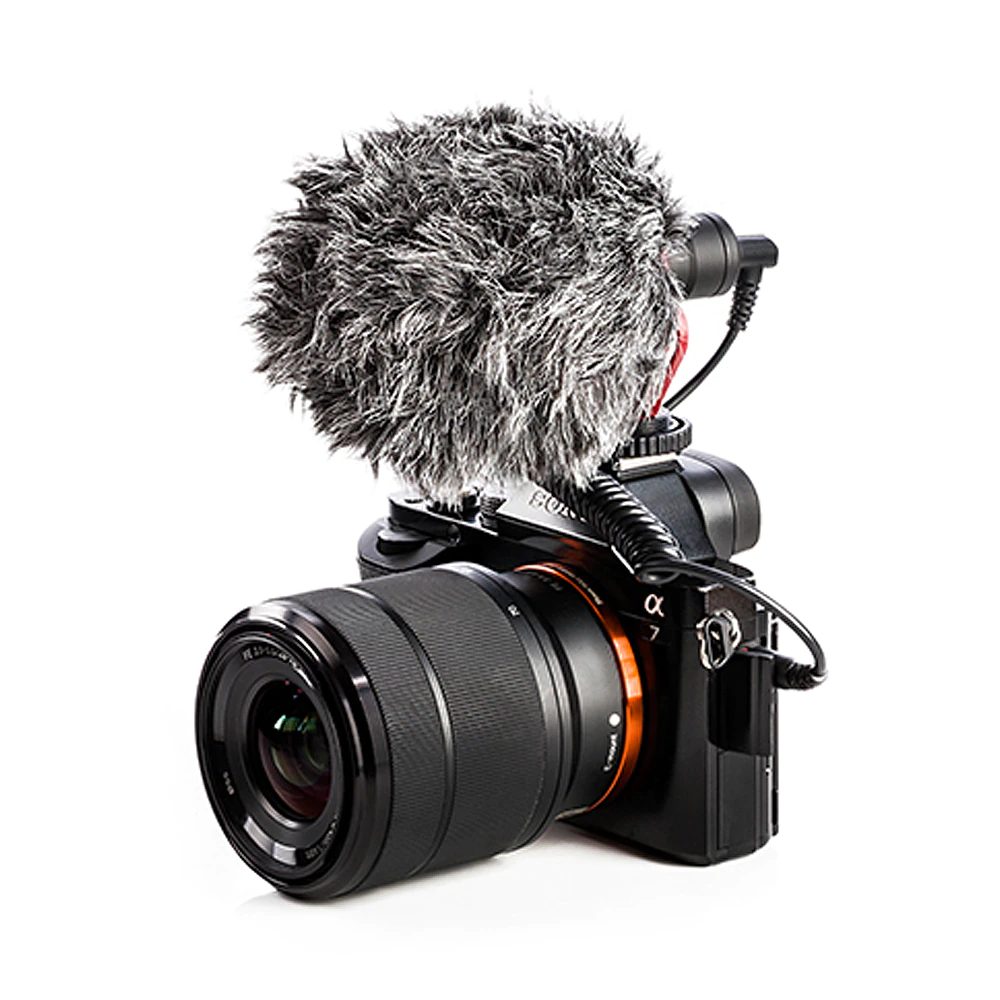
Introducing the Canon EOS Rebel SL3, also known as the EOS 250D or Kiss X10—a compact DSLR camera packed with a host of features that’ll make both photography enthusiasts and videographers leap for joy.
While its built-in microphone is a convenient option for casual recording, it often falls short in terms of audio quality and performance.
So, if you’re aiming for that professional-grade sound quality, there’s one simple solution: an external microphone. In this blog, I’ll share four of my absolute favorite external mics for Canon Rebel SL3 and talk about their respective pros and cons to help you choose the best external mic for your needs.
Mics For Canon Rebel SL3 Top Picks
These handpicked microphones have garnered praise from content creators from all over the world. Whether you’re a seasoned or an aspiring content videographer, these mics offer exceptional audio quality and compatibility with your Canon Rebel SL3 device.
| Microphone | Price | Availability |
| Sennheiser MKE 400 | $199.95 | Check On Amazon |
| Rode VideoMic Pro+ | $221 | Check On Amazon |
| Rode VideoMic GO II | $98 | Check On Amazon |
| Comica CVM-V30 PRO | $46.99 | Check On Amazon |
Sennheiser MKE 400
The Sennheiser MKE 400 is a compact, highly directional super-cardioid shotgun microphone designed to improve and isolate audio quality in video recordings. It shares similarities with its predecessor, the MKE 200, featuring built-in wind protection and integrated shock absorption (but with even more features).
The microphone offers additional flexibility and control with its built-in low-cut filter and 3-step sensitivity switch, allowing optimal performance in various environments.
The MKE 400 includes an integrated headphone output jack with volume adjustment to facilitate audio monitoring. It offers versatile connectivity options with interchangeable 3.5 mm TRS and TRRS connections compatible with DSLR/M cameras and mobile devices.

For those seeking a nice mobile audio recording solution, the MKE 400 Mobile Kit is available. It includes the MKE 400 microphone, the Sennheiser Smartphone Clamp, and the Manfrotto PIXI Mini Tripod, providing everything you’ll need for professional-grade sound capture on the go.
One drawback of this microphone is its sensitivity to handling noise and vibrations. While the integrated shock mount helps to minimize these issues, it may not eliminate them, especially in harsher conditions.
Pros and Cons of Sennheiser MKE 400

Rode VideoMic Pro+
The Rode VideoMic Pro+ is an exceptional on-camera microphone renowned for capturing broadcast-quality audio across a wide range of recording situations. Its extensive features and outstanding sound quality make it the microphone of choice for many content creators.
Equipped with a broadcast-grade condenser capsule, extended frequency response, and an effective super cardioid polar pattern, the VideoMic Pro+ can capture rich, warm, and highly directional audio.

What’s more, this mic has a high-pass filter that effectively minimizes low-end rumble from noises like traffic and air conditions. It also has a high-frequency boost feature and a three-stage gain control so you can achieve perfect recording levels without effort.
For enhanced versatility, the VideoMic Pro+ offers flexible power options. It can be powered by the included rechargeable lithium-ion battery, two AA batteries, or convenient USB charging. It also has an auto power off/on mode to prolong battery life and a safety channel to guarantee that your backup recordings are always available.
Do note that the VideoMic Pro+ is relatively larger and heavier. If you’re looking for a portable microphone for extended periods, this may not be the best choice for you.
Pros and Cons of Rode VideoMic Pro+

Rode VideoMic GO II
If you want a mic that’s ultra-lightweight and compact but still relatively powerful, then VideoMic GO II might be just what you’re looking for. Weighing only 89 grams, it’s incredibly portable and convenient to carry anywhere. Its size makes it an ideal companion for your Canon Rebel SL3, mobile recording setups, or even for your desktop.

The Rode VideoMic GO II utilizes the same annular line tube technology in their highly acclaimed VideoMic NTG and NTG5 microphones. This cutting-edge technology guarantees rich, full audio perfect for a wide range of recording applications. With its highly directional pickup pattern, the microphone can zero in on your desired sound source, delivering crystal-clear, professional-grade audio quality.
To further elevate your recording experience, the VideoMic GO II comes equipped with a high-quality windshield and shock mount.
What’s more, GO II seamlessly integrates with the Rode app suite, granting users access to a plethora of advanced features and robust audio processing capabilities.
This mic doesn’t offer a high-pass filter or gain control when paired with a camera. So if you require such capabilities, Rode’s higher-end options, like the VideoMic Pro+, are better.
Pros and Cons of Rode VideoMic GO II

Comica CVM-V30 Pro
If you don’t have the budget for Rode microphones, a nice alternative is the Comica CVM-V30 Pro. The CVM-V30 PRO microphone weighs approximately 109 grams when equipped with two AAA batteries. Its construction is fairly sturdy and well-built, with no noticeable areas of looseness on the main unit.
This mic is equipped with a convenient low-cut filter and a 10dB sensitivity adjustment. It also has a super-cardioid polar pattern that offers excellent off-axis rejection. To learn more about different polar patterns, check out this article.

What’s more, the CVM-V30 PRO is compatible with a wide range of cameras featuring a 3.5mm (TRS) audio input jack. And it has a 1/4″ external port that simplifies the mounting process onto your camera or other equipment. The entire microphone fitting is mounted low. While this is not an issue when using the foam cover, it can become problematic when using the dead-cat windscreen. To prevent the fur from obstructing your shot, make sure there is enough space between the microphone and the frame of your camera or subject.
It’s also worth noting that the Comica CVM-V30 PRO microphone operates using a 3A battery, which is not included in the product. Make sure to always have suitable batteries to power the microphone during your recording sessions.
Pros and Cons of Comica CVM-V30 Pro

You Can Also Read: The Best Mics for Panasonic S5 In 2023 | Review, Buying Guide, FAQS
Conclusion
Whether you’re a vlogger, filmmaker, or simply someone passionate about capturing high-quality audio, the recommended microphones for the Canon Rebel SL3 offer excellent features and performance. By investing in one of them, you can elevate the overall quality of your video productions and deliver a more immersive and engaging experience for your viewers.
Frequently Asked Questions About the Best Mics For Canon Rebel SL3 (250D)
Does the Canon Rebel SL3 have a mic input?
Yes, the Canon Rebel SL3 does have a mic input. It is equipped with a 3.5mm (TRS) audio input jack, which allows you to connect an external microphone for improved audio recording capabilities.
How do I connect external mics to my Canon camera?
To connect an external microphone to your Canon camera, follow these steps:
1. Power off the camera.
2. Locate the camera’s 3.5mm (TRS) audio input jack.
3. Use a compatible audio cable to connect the microphone to the camera.
4. Ensure the connection is secure.
5. Power on the camera.
6. Access the audio settings in the camera’s menu.
7. Set the input source to “External Mic” or “Mic Input.”
8. Adjust any additional audio settings if needed.
9. Perform a test recording to confirm proper functionality.
10. Refer to your camera’s manual for detailed instructions and specific features.
Can I use a normal microphone for DSLR?
Yes, but while using a regular microphone can enhance audio quality compared to the built-in microphone of a DSLR camera, dedicated shotgun microphones or external microphones specifically designed for DSLR cameras provide even better results.







